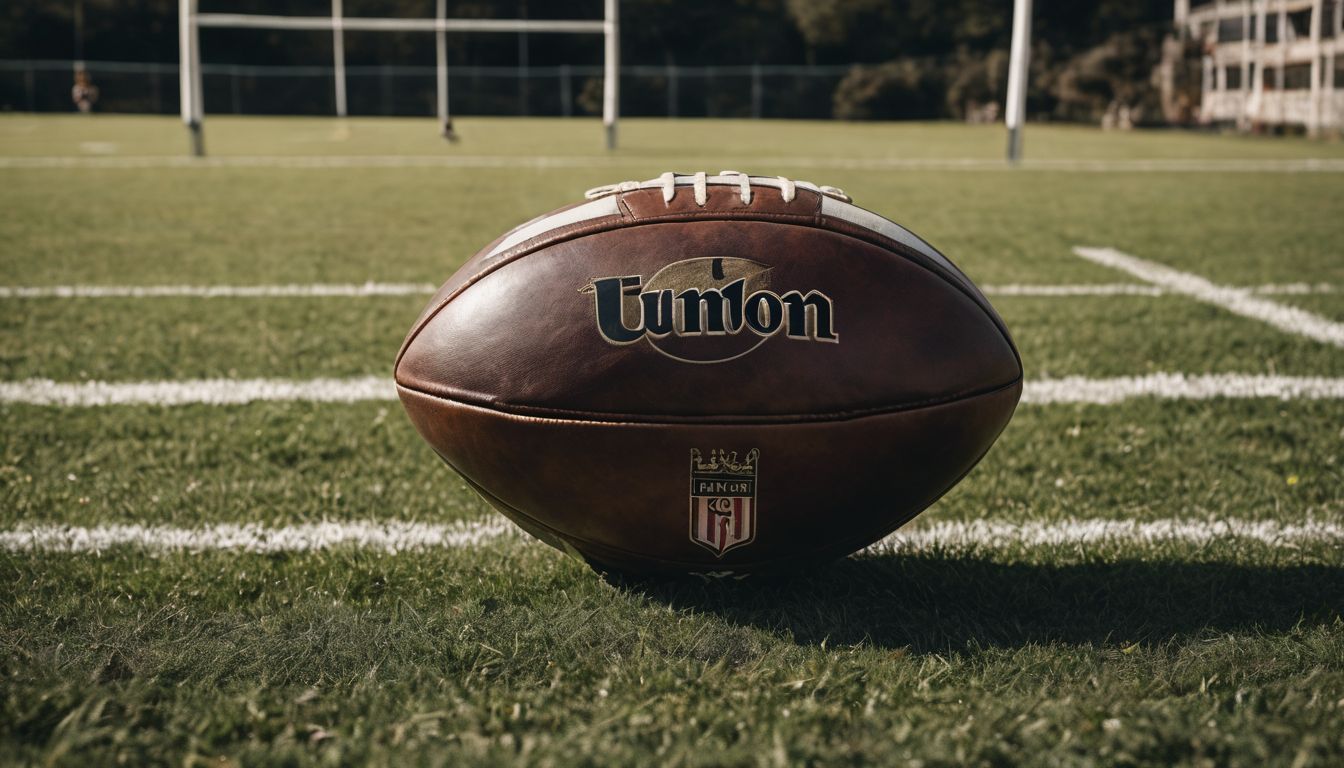Ever watched a rugby match and found yourself puzzled by the scrum of players, unsure if it’s a ruck or a maul? Here’s something to clear up that confusion: while both involve intense close-quarters play, they’re governed by different rules.
In this post, we’ll break down these two vital elements of rugby into bite-sized explanations that will turn your bewilderment into insight. Get ready to impress your mates with your newfound rugby savvy!
Key Takeaways
- A ruck occurs when the ball is on the ground and players from both teams must bind over it to compete for possession, staying on their feet and using their strength.
- In contrast, a maul involves at least one player holding the ball whilst teammates bind onto them. The group can move forward together, with the ball off the ground.
- It’s essential for players to join a ruck or maul correctly: through the ‘gate’ in a ruck or by binding properly in a maul to uphold fair play and safety.
- The outcomes of successful rucks and mauls directly impact gameplay by allowing teams to keep possession or gain territory, creating opportunities for scoring plays.
- Players who disobey rules governing rucks and mauls face penalties. These include free kicks for being offside or penalisation for collapsing a maul intentionally.
Understanding Rucks and Mauls
Rucks and mauls are fundamental aspects of rugby, involving the ball carrier, opponents, and teammates in different ways. Understanding their purpose and differences is crucial for a deeper appreciation of the game.
Basics of rugby terminology
Rugby terminology can seem like a whole new language to newcomers, but it’s essential for understanding the game. A “ruck” occurs when the ball hits the ground during play; players from both teams then bind together over it, trying to secure possession by moving forward.
They must stay on their feet as they fight for control of the ball using their strength and tactics. Meanwhile, a “maul” happens when a player holding the ball is met by an opponent and teammates latch onto this battle without any part of their bodies touching the ground.
In these gritty contests, only players who are ‘on-side‘—meaning they arrived through their team’s gate or area at that breakdown—can join in. This ensures fair competition and minimises chaos around the pivotal moments of rucks and mauls.
Each situation demands different skills: brute force might win you a maul while agility and quick thinking could turn a ruck in your favour. Understanding these terms helps fans appreciate just how strategic rugby is, every run and tackle building up to these critical engagements between opponents.
Purpose of rucks and mauls
Rucks and mauls serve the crucial purpose of recycling possession in rugby. In a fast-paced game like rugby, these phases allow teams to retain the ball and create opportunities for further attacking plays.
By forming rucks or mauls, players can secure the ball and maintain control over their gameplay, preventing turnovers that could put them at a disadvantage on the pitch.
During rucks and mauls, team members work together to support the ball carrier or teammate in possession, enabling them to keep hold of the ball while under pressure from opponents.
Key differences between the two
Understanding the distinction between a ruck and a maul is fundamental for any rugby fan. While both formations are pivotal during a match, they have unique characteristics that set them apart. Here’s a table summarising the key differences:
| Ruck | Maul |
|---|---|
| The ball is on the ground. | The ball is off the ground, in a player’s hands. |
| It is formed post-tackle with at least one player from each team over the ball. | Initiated when the ball carrier and a teammate are held by at least one opponent. |
| Players contest for the ball on the ground using their feet. | Players push forward in an attempt to gain ground with the ball secured within. |
| Players cannot handle the ball until it is won. | The ball can be shifted and passed between players in the maul. |
| Other players must enter through the ‘gate’, the area directly behind the hindmost foot of the last ruck participant. | Players can join from any angle as long as they bind onto the maul correctly. |
| Once the ball is clearly won, it must be played quickly. | The maul can continue moving forward until the ball is grounded or becomes unplayable. |
Moving on, let’s delve into the specific characteristics of rucks and mauls that impact the flow of the game.
Characteristics of Rucks and Mauls
– Rucks involve players on their feet, close to the ball, while mauls involve players from both teams bound together around a ball carrier. The direction of movement also differs between the two, with rucks usually moving towards the opposition’s try line and mauls being more stationary.
Involvement of players
During a ruck, players from both teams bind together and work to secure possession of the ball. The player who has gone to ground with the ball is supported by teammates who bind onto them before engaging opponents.
This creates a physical contest as both teams push against each other, aiming to gain control of the ball. In contrast, in a maul, at least one teammate binds onto an opponent while holding the ball off the ground.
This prompts other players to join in and bind on as well, creating a structure where strength and coordination are essential for gaining territory or recycling possession.
Direction of movement
Rucks and mauls involve dynamic movements on the field, each with its distinct direction. In a ruck, players bound over the ball, aiming to drive it towards the opposition’s try line.
The collective effort is directed towards maintaining possession or recycling the ball for attacking plays. On the other hand, in a maul, the primary movement entails driving forward while keeping possession of the ball within the group of players involved.
This strategic advancement aims to gain territory and create opportunities for scoring points.
Ball placement
When discussing ball placement in rugby, it’s essential to understand that the position of the ball determines whether a ruck or maul is formed. In a ruck, the ball is placed on the ground, initiating the bound players and creating an opportunity for intense competition to gain possession.
Conversely, in a maul, the ball remains off the ground and typically within reach of one player while teammates bind onto them. This strategic difference profoundly influences tactics and gameplay as teams strive to secure possession or advance towards their goal line.
The distinction in ball placement between rucks and mauls underscores the fundamental importance of positioning in rugby. It dictates how players engage with each other and contributes significantly to strategic decision-making during matches.
Rules and Regulations
Laws governing rucks and mauls, including the specifics of player involvement, ball placement, and penalties for infringements.
To find out more about the rules and regulations that govern rucks and mauls in rugby, keep reading!
Laws governing rucks and mauls
The laws governing rucks and mauls are crucial for fair play and player safety in rugby. They outline the specific rules and techniques for both attacking and defending in these situations, making them integral parts of the game. The following points highlight some key aspects of the laws governing rucks and mauls:
- Players must join a ruck or maul from behind the hindmost player.
- The offside line is formed when a ruck or maul occurs, and players must adhere to it.
- Referees closely monitor players entering a ruck or maul from the side, ensuring fair play.
- Proper binding is essential in both rucks and mauls to maintain stability and safety.
- Use of hands while on the ground in a ruck or maul is regulated to prevent unfair play.
- Players need to release the ball immediately upon hitting the ground during a tackle, maintaining fluidity in gameplay.
- Head contact is strictly regulated to ensure player safety during rucks and mauls.
- Referees enforce strict timing rules for players joining and engaging with a ruck or maul.
Penalties for infringements
Understanding the laws governing rucks and mauls provides clarity on the penalties for infringements. When players breach these rules, penalties are imposed to ensure fair play and safety. Here are specific penalties for infractions:
- Offside Position: When a player is in front of the hindmost foot of the teammate at a ruck or maul, an offside penalty is given, resulting in a free kick for the non-offending team.
- Not Rolling Away: If a player does not roll away from the tackled player or releases the ball within a reasonable time, they will incur a penalty, allowing the opposition to increase their field position.
- Sealing Off: A penalty is awarded if an attacking player intentionally impedes opponents from contesting possession by sealing off or creating a barrier over the ball carrier at a ruck or maul.
- Hands in the Ruck: Players who use their hands to interfere with the ball when it’s on the ground in a ruck face penalties, as it disrupts fair competition and prompts sanctions.
- Entering From The Side: Any player entering a ruck or maul from an offside position and not through the “gate” area between their own teammates commits an offence and incurs penalisation.
- Collapsing A Maul: If players deliberately collapse a maul to prevent opponents from advancing legally, they face penalties that may lead to yellow cards for repeated offences.
- Foul Play: Serious infringements like punching, kicking, head-butting, or dangerous tackles during rucks and mauls result in severe penalties such as yellow or red cards.
Importance in the Game
Rucks and mauls are crucial in creating attacking opportunities and gaining territory on the rugby field. To understand their significance, dive into the strategic use of these plays in different game situations by reading more!
Impact on gameplay
Rucks and mauls play a pivotal role in shaping the flow of a rugby game. These situations require quick thinking, strength, and teamwork from players to gain possession of the ball or defend against the opposing team.
The outcome of rucks and mauls can heavily influence the momentum and direction of the match, making them crucial strategic elements that demand intense focus from all players involved.
When a ruck or maul is successfully executed, it provides an opportunity for the attacking team to maintain possession and create scoring opportunities. Additionally, defensive teams strive to disrupt these formations by using tactical maneuvers to regain control of the ball.
Strategic use in different situations
Teams strategically use rucks and mauls to gain territory, maintain possession of the ball, and create scoring opportunities. In attacking situations, players aim to set up quick rucks to secure the ball and provide a platform for their team’s next phase of play.
This is vital for maintaining momentum and putting pressure on the opposition. On the other hand, defending teams look to disrupt or slow down opposition ball at rucks and mauls by contesting possession aggressively or causing turnovers.
Understanding these strategic nuances enables teams to adapt their tactics according to the flow of the game.
In high-pressure moments during a match, such as near the try line or when striving for field position, effective management of rucks and mauls becomes crucial. Teams must make split-second decisions about whether to commit more players into a particular breakdown or quickly move the ball out wide before defences have time to reorganise.
Conclusion
Understanding the distinction between a ruck and a maul is vital for rugby players. The position of the ball serves as the primary differentiator. In a ruck, the ball is on the ground, whereas in a maul, it typically rests in a player’s hands.
Winning either requires teamwork, strength, and strategic play. Players must grasp the laws and tactics governing these essential aspects of rugby for fair and safe gameplay.
FAQs
1. What is a ruck in rugby?
A ruck happens in rugby union and league games when the ball hits the ground and players use their feet to vie for it, staying on their feet while grabbing each other for support.
2. What exactly is a maul in rugby?
In a maul, which occurs chiefly in rugby union after a lineout or during play, the player holding the ball stays upright and teammates bind together to push against opponents and gain ground.
3. How are rucks and mauls different?
The difference lies in possession; in a ruck, the ball must be on the ground, while in a maul, it’s held by one player who tries to advance with teammates’ aid as opponents attempt to halt them.
4. Are rucks and mauls found in all types of rugby?
Rucks appear across various forms such as Rugby Union, Rugby League, and Rugby Sevens but mauls mainly occur within Rugby Union matches.
















